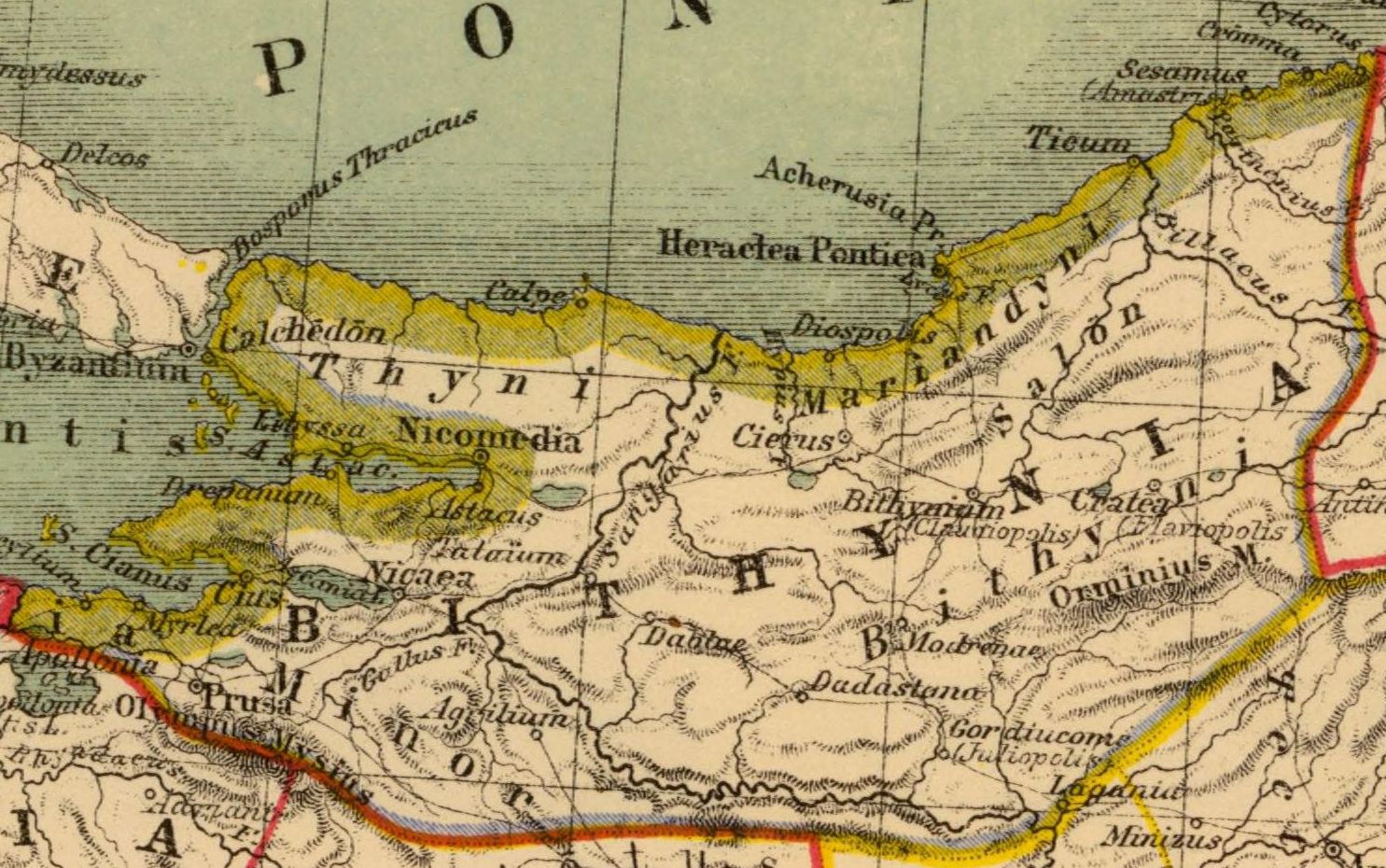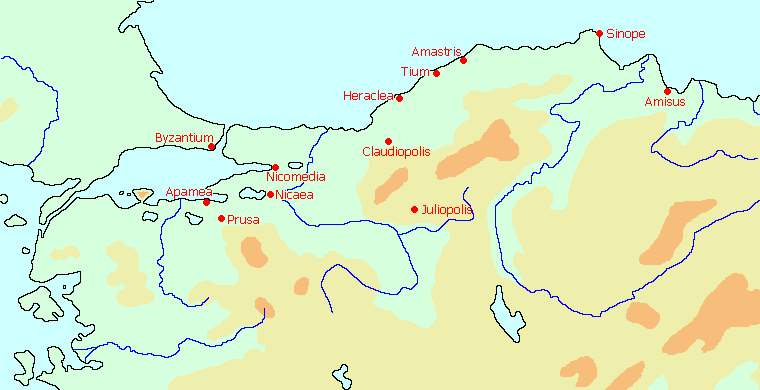Bithynia
Bithynia (Greek Βιθυνία, Bithynia ) was originally an ancient landscape, later a kingdom, then a Roman province in northwestern Asia Minor. In Bithynia, the Thracian tribes of Thynier and Bithynians were located.
- 4.1 dynasts
- 4.2 kings
Geography
Bithynia is bounded to the west and north by the Sea of Marmara and the Pontos Euxinos ( Black Sea), to the south of Olympos ( Keşiş Dağ ) at about 40 ° N. lat. To the east, it separates the Parthenius (now Bartan Su ) of Paphlagonia; to the south are the adjoining countries of Galatia, Phrygia and Mysia.
The country is in the east and south by wooded mountains marked (except the Olympos in Bursa, the Orminios, now Isik Dağ, in the east); the lower and intersected by fertile valleys western half contains some large inland lakes, such as Lake Askanische ( Iznik Gölü ) at Nicaea ( Iznik ) and the Artynischen See ( Uluabat Gölü ) on which Apollonia is located.
Here in the West also cut two Gulf deep into the mainland one: that of Astacus ( at today İzmit ) and of Kios ( Gemlik at today ). The largest river is the Sangarius ( Sakarya ); also the Billäos (now Filias ) in the eastern half.
Cities
- Chalcedon
- Helenopolis
- Nicomedia (now Izmit )
- Nicaea (now Iznik )
- Prusa (now Bursa)
- Prusias ad Hypium
History
The political education of Bithynia was around 430 BC under Doidalses, who founded a dynastic. Against the Persian satraps, the country was able to maintain its independence.
The satraps of Alexander the Great, Kalas, the Bithynian dynast Bas was 333/28 ward BC. Antigonus Monophthalmos held the expansionist ambitions of his son and successor Zipoites ' on to the Greek cities of the area. Zipoites turned hostages, and seems to have been allied with Antigonus, how strong was the function of this is controversial in research. In the following years Zipoites could assert against Lysimachus and two of his generals. A victory over those he took probably in autumn 297 BC to reason to assume the title of king. Shortly after the Battle of Kurupedion (281 BC) died Zipoites. His son and successor Nicomedes I. continued his father's policy continues, the respective political climate adapting to seek territorial gains. He fought with success against Antiochus I Soter, 277 BC an alliance with the Galatians and expanded his empire through the conquest of the north-eastern part of Phrygia. 264 BC he founded the capital city of Nicomedia.
Under Prusias I reached Bithynia its greatest extent 184 BC and took the fugitive Hannibal, but she was not able to protect against the Romans. The last king, Nicomedes IV, was of Mithridates VI. distributed by Pontus twice, but each used new from the Romans. At his death, 74 BC he bequeathed his kingdom to the Romans, who also claimed under Lucullus against Mithridates.
Roman province
Bithynia became a Roman province, the capital remains Nicomedia, and initially formed with the province of Asia a customs district. 64 BC the province of Bithynia et Pontus double is established.
Bithynia is from 27 BCE to Province under Marcus Aurelius almost continuously senatorial. Imperial province is repeatedly under Claudius and Nero. Also known as Pliny the Younger here is 109-111 under Trajan Legat, it is apparently under direct imperial administration. The Exchange of Letters of Pliny with his emperor is an important source for the administrative history of Rome in general and for Bithynia in particular. Extraordinary fame of the letter in which Pliny requests, how to deal with the spread in Bithynia as a disease Christianity: "Not only about the cities but also about the villages and the countryside, the plague of this evil superstition has spread. " ( Pliny Ep. 10,96,9 ). Already the cover letter of 1 Peter ( " Peter, an apostle of Jesus Christ, to the strangers scattered abroad throughout Pontus [ ... ] and Bithynia ...") has a presence of the Apostle in the 40s of the first century. To close, but which is not historically verifiable.
In the province of reform of Diocletian 295 it was divided into the provinces of Bithynia, Paphlagonia and Diospontus.
This Bithynia was not an administrative unit more already in the Byzantine Empire and was the subject of Opsikion allocated to the provincial reform in the 7th century, later divided between this and the topic Optimatoi.
Crusades
1074-1097 was the land owned by the Seljuks, to the knights of the First Crusade took back the land for the Byzantine Empire. During the period of the Latin Empire in Constantinople Opel (1204-1261) was Nicaea in Bithynia seat of the Greek emperor. After 1298, the Ottoman Sultan Osman I. undertook several plundering expeditions into Bithynia. His victory over a Byzantine army at the Battle of Bapheus (1302 ) introduced the Ottoman occupation of this region. 1326 was eventually conquered Prusa ( Bursa) capital of the Ottoman Empire.
List of rulers of Bithynia
Dynasts
- Doidalses ( attested 435/4 BC)
- Boteiras (? -377/6 BC)
- Bas ( 377/6-328 BC)
Kings
- Zipoites ( 328-280 BC)
- Nicomedes I ( 280-255/3 BC)
- Ziaelas (ca. 250 -ca. 230 BC)
- Prusias I (ca. 230-182 BC)
- Prusias II ( 182-149 BC)
- Nicomedes II Epiphanes ( 149-128/7 BC)
- Nicomedes III. Euergetes ( 128/7-ca. 94 BC)
- Nicomedes IV Philopator (ca. 94-74 BC)
Roman time
Selected Roman proconsuls, procurators and legacies ( the imputed in this list Zweijährigkeit the official guide can be used only in a few cases ):
Personalities
- Asclepiades of Bithynia (c. 124 BC in Prusa in Bithynia, Asia Minor, † 60 BC in Rome ) Greek physician and philosopher









